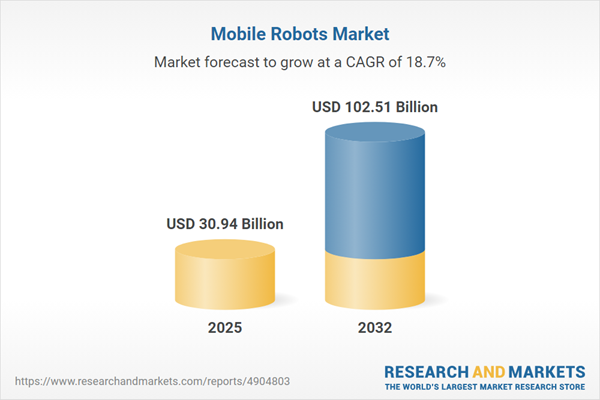Speak directly to the analyst to clarify any post sales queries you may have.
The mobile robots market is redefining how industries automate operations, facilitating advanced human-machine collaboration and streamlined logistics. Senior leaders are turning to mobile robotics for new efficiencies, improved supply chain resilience, and scalable automation in competitive environments.
Market Snapshot: Mobile Robots Market Growth and Opportunity
The Mobile Robots Market grew from USD 26.01 billion in 2024 to USD 30.94 billion in 2025. It is expected to continue growing at a CAGR of 18.69%, reaching USD 102.51 billion by 2032. This dynamic expansion underscores the sector’s accelerating demand, driven by next-generation automation, AI integration, and responsive logistics solutions.
Scope & Segmentation: Mobile Robotics Applications, Channels, and End Users
This report presents an in-depth analysis of the mobile robotics landscape across core segments, emphasizing the integration of transformative technologies and evolving application areas:
- Robot Types: Automated guided vehicles (laser guided, magnetic tape guided with embossed and standard tape, vision guided, wire guided including dual and single wire), and autonomous mobile robots (laser navigation, 2D/3D LiDAR, magnetic and vision navigation).
- Distribution Channels: Offline procurement and online platforms offering software-as-a-service and fleet solutions.
- Applications: Cleaning, disinfection, inspection, and delivery services (in-plant and last-mile), alongside material handling (bin picking, cart and pallet transport).
- End Users: Healthcare organizations, logistics and warehousing providers (manufacturing, retail, third party), retail enterprises, as well as manufacturing sectors such as automotive, electronics, food & beverage, and pharmaceuticals.
- Regions: Americas (United States, Canada, Mexico, Brazil, Argentina, Chile, Colombia, Peru), Europe, Middle East & Africa (including UK, Germany, France, Russia, Italy, Spain, Netherlands, Sweden, Poland, Switzerland, UAE, Saudi Arabia, Qatar, Turkey, Israel, South Africa, Nigeria, Egypt, Kenya), and Asia-Pacific (China, India, Japan, Australia, South Korea, Indonesia, Thailand, Malaysia, Singapore, Taiwan).
- Leading Companies: Toyota Industries Corporation, KION Group AG, Daifuku Co., Ltd., Murata Machinery, Ltd., ABB Ltd., KUKA Aktiengesellschaft, Omron Corporation, JBT Corporation, Honeywell International Inc., and iRobot Corporation.
Key Takeaways: Executive Insights for Decision-Makers
- Mobile robotics has shifted from specialized deployments to being central for operational excellence across manufacturing, logistics, and service sectors.
- Artificial intelligence, advanced sensors, and robust connectivity drive adoption, making fully autonomous systems viable in diverse and dynamic environments.
- Workforce optimization challenges and a focus on supply chain continuity are accelerating the integration of collaborative robots and adaptive automation solutions.
- Regulatory clarity and expanded safety standards enable seamless fleet integration, encouraging widespread enterprise trials and full-scale automation rollouts.
- The market’s competitive landscape is shaped by both incumbent industrial leaders and agile technology innovators, spurring rapid advances and ecosystem expansion.
- Expanding beyond traditional material handling, mobile robots now address disinfection, inspection, and in-plant deliveries, unlocking fresh operational value across public and private sectors.
Tariff Impact: United States Policy Shifts and Supply Chain Strategies
United States tariffs introduced in 2025 on imported robotics components are reshaping sourcing and procurement for industry stakeholders. Organizations are responding by recalibrating supply strategies, exploring near-shoring opportunities, and investing in domestic manufacturing to offset cost volatility. This evolving landscape encourages strategic supplier diversification and increased research and development into component localization, bolstering long-term supply chain resilience.
Methodology & Data Sources
The analysis combines primary interviews with industry executives and technology specialists, robust secondary research from regulatory filings and market reports, and advanced statistical techniques to validate trends. Rigorous segmentation, expert panel reviews, and thematic coding ensure the reliability and actionable value of the findings.
Why This Report Matters: Decision-Grade Insights for Strategic Planning
- Identify growth opportunities, technology adoption patterns, and supply chain strengths to guide investment decisions and automation roadmap planning.
- Leverage competitive benchmarking and segmentation analysis tailored to your sector and geographic priorities.
- Inform operational strategies and C-suite alignment with rigorously validated market intelligence and trend forecasts.
Conclusion: Steering Future-Ready Mobile Robotics Strategies
The mobile robots market is at a turning point, with adaptive automation, evolving trade dynamics, and ecosystem expansion propelling innovation. Forward-looking organizations that align with these shifts will capture growth and drive sustainable operational advantage across industries.
Additional Product Information:
- Purchase of this report includes 1 year online access with quarterly updates.
- This report can be updated on request. Please contact our Customer Experience team using the Ask a Question widget on our website.
Table of Contents
3. Executive Summary
4. Market Overview
7. Cumulative Impact of Artificial Intelligence 2025
Companies Mentioned
The companies profiled in this Mobile Robots market report include:- Toyota Industries Corporation
- KION Group AG
- Daifuku Co., Ltd.
- Murata Machinery, Ltd.
- ABB Ltd.
- KUKA Aktiengesellschaft
- Omron Corporation
- JBT Corporation
- Honeywell International Inc.
- iRobot Corporation
Table Information
| Report Attribute | Details |
|---|---|
| No. of Pages | 193 |
| Published | October 2025 |
| Forecast Period | 2025 - 2032 |
| Estimated Market Value ( USD | $ 30.94 Billion |
| Forecasted Market Value ( USD | $ 102.51 Billion |
| Compound Annual Growth Rate | 18.6% |
| Regions Covered | Global |
| No. of Companies Mentioned | 11 |









